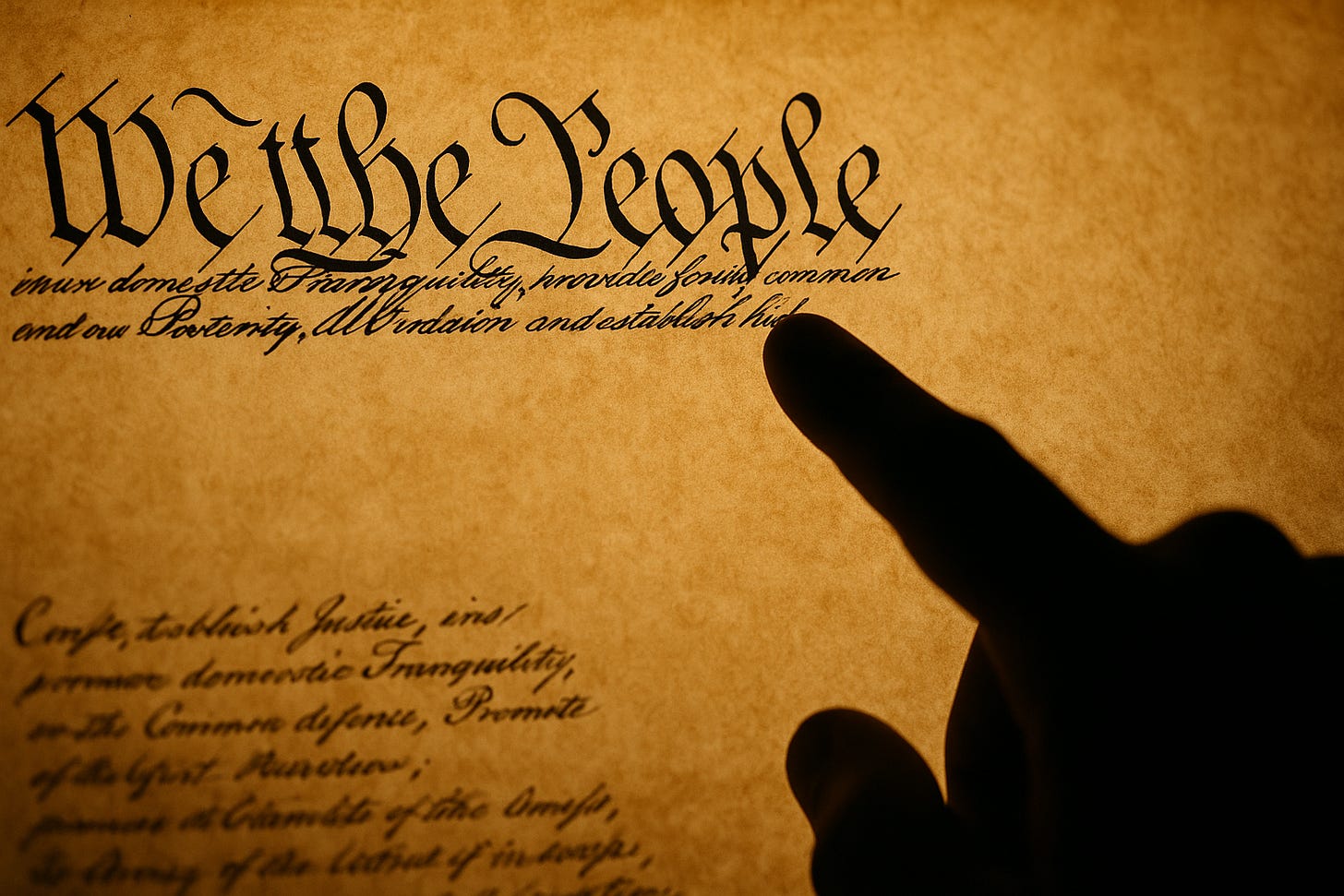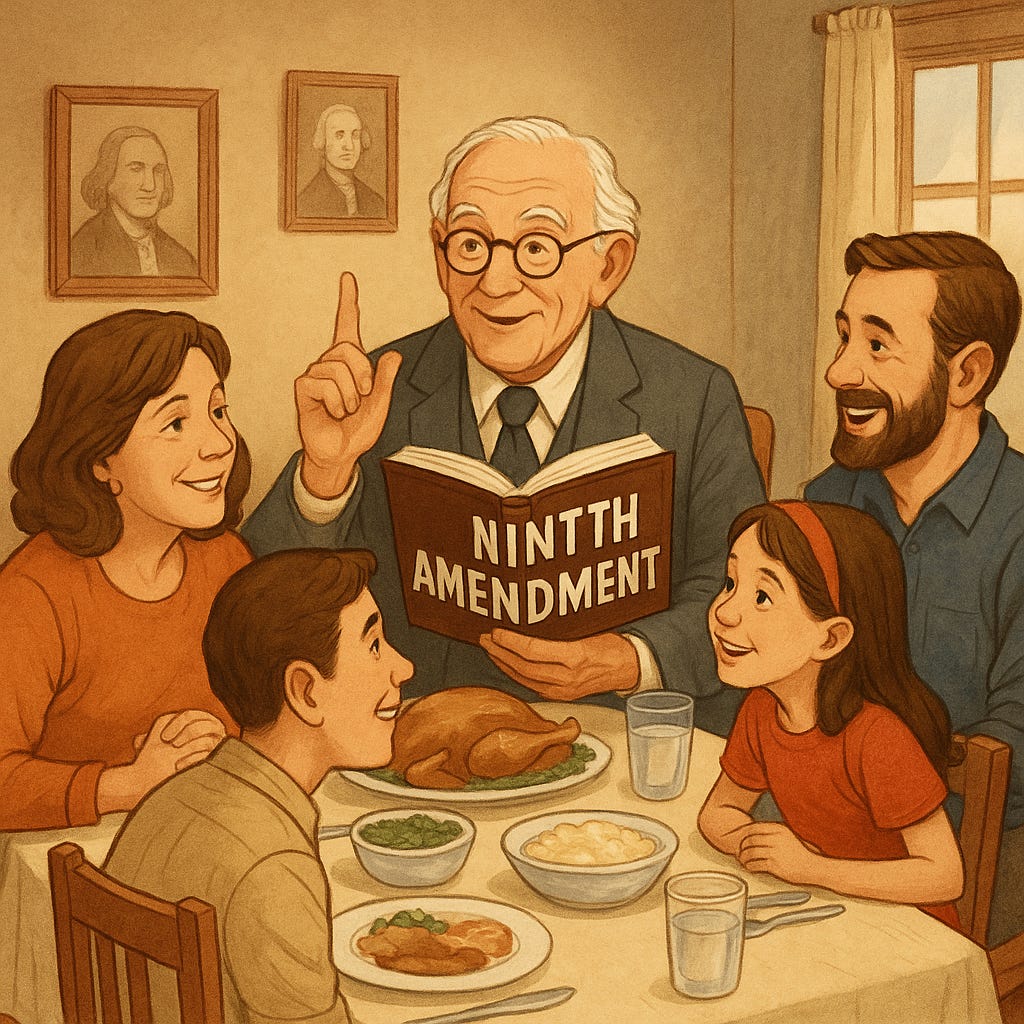11. The Ninth Amendment: A Hidden Key?
How an overlooked clause helped unlock modern constitutional rights
Every so often, a sleepy part of the Constitution suddenly finds itself in the spotlight.
That’s exactly what happened to the Ninth Amendment in 1965, when the Supreme Court struck down Connecticut’s ban on birth control for married couples in Griswold v. Connecticut.
Justice William O. Douglas’s majority opinion told us:
The Ninth Amendment provides: “The enumeration in the Constitution, of certain rights, shall not be construed to deny or disparage others retained by the people.”
Earlier in the opinion, Douglas also wrote:
[S]pecific guarantees in the Bill of Rights have penumbras, formed by emanations from those guarantees that help give them life and substance.
Translation: There’s more to constitutional rights than what’s written down.
Wait — the Constitution protects rights that aren’t even listed? Now that’s intriguing. But what exactly does this open-ended clause mean — and how have scholars and judges tried to make sense of it?
That sounds pretty sweeping. But here’s the catch: can courts actually use it? Is it enforceable? Does it create new rights? Is it just a philosophical nudge?
Let’s dig in.
Five Models of the Ninth Amendment
Since the 1980s, scholars have offered five main theories about what the Ninth is actually doing. Some give it real legal power. Others see it as more of a polite constitutional reminder.
So when judges read this mysterious sentence, how exactly are they supposed to use it? Let’s walk through the options.
1. State Law Rights Model
This view says the Ninth protects rights already recognized in state law—rights in state constitutions or common law. It wasn’t meant to create new federal rights or give federal courts new powers. It was just there to make sure the new federal Constitution didn’t accidentally erase rights people already enjoyed at the state level.
In this model, the Ninth is a shield for state traditions, not a sword for new national rights.
2. Residual Rights Model
Now we’re in rule-of-construction territory. This model sees the Ninth as a way to block a bad argument: that listing some rights in the Bill of Rights somehow expanded federal power.
In other words, the Ninth is a constitutional reminder: “Just because we wrote some rights down doesn’t mean Congress gets new powers.” Less about protecting personal rights, more about keeping Congress in its lane.
3. Individual Natural Rights Model
Here’s where things get exciting—and the model that best matches how Douglas used the Ninth in Griswold.
The idea here is that the Ninth protects natural rights, i.e., rights that people had before government existed and still retain afterward. Rights like privacy, bodily autonomy, freedom to make intimate decisions.
Under this model, unenumerated rights are just as real (and just as protected) as the ones spelled out in the text. And courts should enforce them accordingly.
4. Collective Rights Model
Shift gears: this model focuses not on individual rights, but on collective political rights. Think of the people’s right to alter or abolish their government, or to exercise popular sovereignty.
In this reading, the Ninth protects “the people” acting collectively, not individual personal rights like privacy or autonomy. It’s more about political freedom than personal liberty.
5. Federalism Model
Finally, we have a version that fits neatly into federalism: the Ninth as a further safeguard against federal overreach.
Here, the Ninth serves as a check on how broadly courts interpret federal powers, especially implied powers under the Necessary & Proper Clause. By keeping federal powers narrow, the Ninth indirectly helps protect both state authority and individual liberty. But again, it doesn’t directly tell courts to enforce specific unenumerated rights.
The Ninth Amendment in Later Cases
Now for the twist: even after Griswold, the Ninth Amendment didn’t become the star of constitutional law.
Yes, the Court referenced it in later cases, but always as supporting background, not as the main tool for striking down laws.
In Roe v. Wade (1973), Justice Blackmun mentioned the Ninth as one possible support for privacy rights, but grounded the decision mainly in the Fourteenth Amendment’s Due Process Clause.
In Richmond Newspapers v. Virginia (1980), Chief Justice Burger referenced the Ninth in discussing the public’s right to attend criminal trials, again as part of the broader context of unenumerated rights.
But here’s the key point: the Court has never used the Ninth Amendment as the sole constitutional basis for recognizing a right or invalidating a law.
Why not? Because the Ninth isn’t like the First or Fourth Amendments. It doesn’t give courts a specific test or standard. It’s more of a guiding principle, a reminder that the Constitution’s list of rights isn’t exhaustive.
Think of the Ninth as the wise elder at the constitutional family dinner: always present, occasionally quoted, but rarely running the show.




My reading of the 9th Amendment is that the writers clearly recognized that they could not feasibly enumerate every single right a person could have or would have in this new republic. When you historically look at what was going on that triggered the Bill of Rights, there are almost direct correlations between what they were currently experiencing, i.e. anti-federalists who were calling for clear protections from a large, controlling government. So, these people had just left Britain and the crown and are essentially writing a new charter to ensure they are not just going to make another mini-Britain in the U.S. The third amendment in response to the Quartering Act, the 2nd Amendment to ensure civilians can always have the ability -- and firepower-- to overthrow a government if it becomes too corrupt; a well-regulated militia of citizens. And then comes the 9th Amendment to say basically that just because something is not spelled out here, does not mean that the right does not exist. That citizens cannot decide they want to protect themselves in other ways. Essentially, the absence or silence on an enumerated right does not mean it does not exist.
I wonder if there are any other amendments like the Ninth Amendment that hint at principles rather than laying out clear rulings? Personally, the Tenth Amendment comes to mind, as it also works as a constitutional reminder and preserves powers not given to the federal government to the states and their people. These both suggest that the Constitution's text does not provide the full story, which makes me think: how much should courts rely on these unwritten rules when deciding our rights and what they really are?